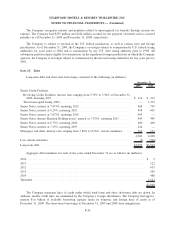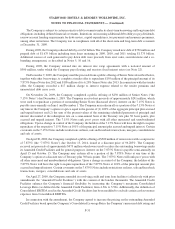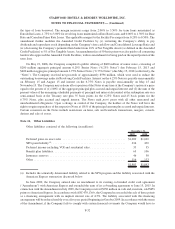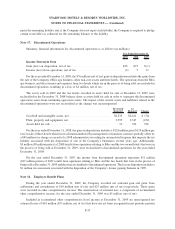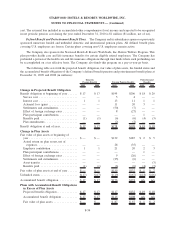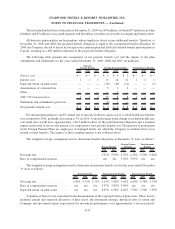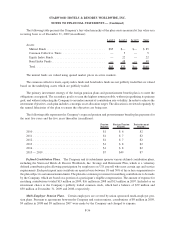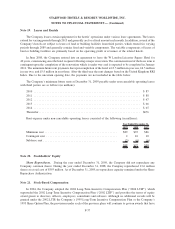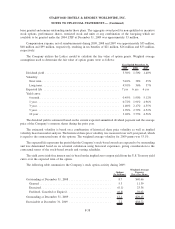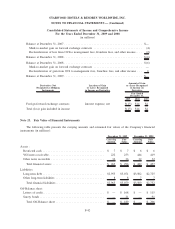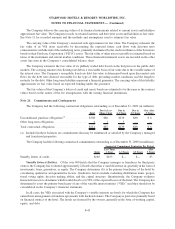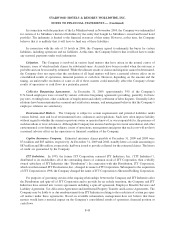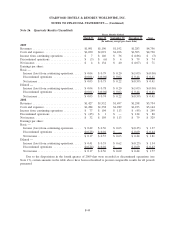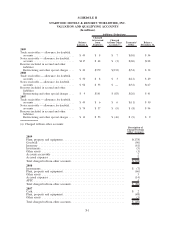Starwood 2009 Annual Report Download - page 163
Download and view the complete annual report
Please find page 163 of the 2009 Starwood annual report below. You can navigate through the pages in the report by either clicking on the pages listed below, or by using the keyword search tool below to find specific information within the annual report.Note 22. Derivative Financial Instruments
The Company enters into forward contracts to manage foreign exchange risk. Beginning in January 2008, the
Company entered into forward contracts to hedge forecasted transactions based in certain foreign currencies,
including the Euro, Canadian Dollar and Yen. These forward contracts have been designated and qualify as cash
flow hedges, and their change in fair value is recorded as a component of other comprehensive income and
reclassified into earnings in the same period or periods in which the forecasted transaction occurs. To qualify as a
hedge, the Company needs to formally document, designate and assess the effectiveness of the transactions that
receive hedge accounting. During 2009, the Company cancelled notional amounts of $4 million related to two
hedges and received cash proceeds of approximately $0.3 million. The notional dollar amounts of the outstanding
Euro and Yen forward contracts at December 31, 2009 are $24 million and $4 million, respectively, with average
exchange rates of 1.4 and 90.5, respectively, with terms of primarily less than one year. The Canadian forward
contracts expired during 2009. The Company reviews the effectiveness of its hedging instruments on a quarterly
basis and records any ineffectiveness into earnings. The Company discontinues hedge accounting for any hedge that
is no longer evaluated to be highly effective. From time to time, the Company may choose to de-designate portions
of hedges when changes in estimates of forecasted transactions occur. During 2009, the Company de-designated
notional amounts of $4 million related to three hedges. Other than the de-designated portions, each of these hedges
was highly effective in offsetting fluctuations in foreign currencies. An insignificant amount of gain due to
ineffectiveness was recorded in the consolidated statements of income during 2009. Additionally, during the year
ended December 31, 2009, 26 forward contracts matured.
The Company also enters into forward contracts to manage foreign exchange risk on intercompany loans that
are not deemed permanently invested. These forward contracts are not designated as hedges, and their change in fair
value is recorded in the Company’s consolidated statements of income at each reporting period.
The Company enters into interest rate swap agreements to manage interest expense. The Company’s objective
is to manage the impact of interest rates on the results of operations, cash flows and the market value of the
Company’s debt. At December 31, 2009, the Company has six interest rate swap agreements with an aggregate
notional amount of $500 million under which the Company pays floating rates and receives fixed rates of interest
(“Fair Value Swaps”). The Fair Value Swaps hedge the change in fair value of certain fixed rate debt related to
fluctuations in interest rates and mature in 2012, 2013 and 2014. The Fair Value Swaps modify the Company’s
interest rate exposure by effectively converting debt with a fixed rate to a floating rate. These interest rate swaps
have been designated and qualify as fair value hedges and have met the requirements to assume zero ineffectiveness.
In the Company’s most recent securitization transaction, the unconsolidated QSPE entered into a balance
guaranteed interest rate swap to fix the interest rate on its debt in order to mitigate interest rate risk for the investors.
In connection with the QSPE swap, the Company also entered into two swaps. The first swap provides a
counterparty to the investors of the QSPE swap and is a balance guaranteed interest rate swap, with the Company
paying a floating rate and receiving a fixed rate. To mitigate the potential impact of the floating to fixed swap, the
Company also entered into a second swap, whereby the Company pays a fixed rate and receives a floating rate, with
interest paid based on an expected amortization schedule rather than a balance guaranteed notional. In December
2009, the second swap was amended for the expected amortization tail. The swaps do not qualify to receive hedge
accounting, and, therefore, the change in fair values will be marked to market at each reporting period with the
change in fair value recorded in the consolidated statements of income. The swaps have the legal right of offset and
resulted in an insignificant net liability at December 31, 2009.
The counterparties to the Company’s derivative financial instruments are major financial institutions. The
Company evaluates the bond ratings of the financial institutions and believes that credit risk is at an acceptable level.
F-40
STARWOOD HOTELS & RESORTS WORLDWIDE, INC.
NOTES TO FINANCIAL STATEMENTS — (Continued)


